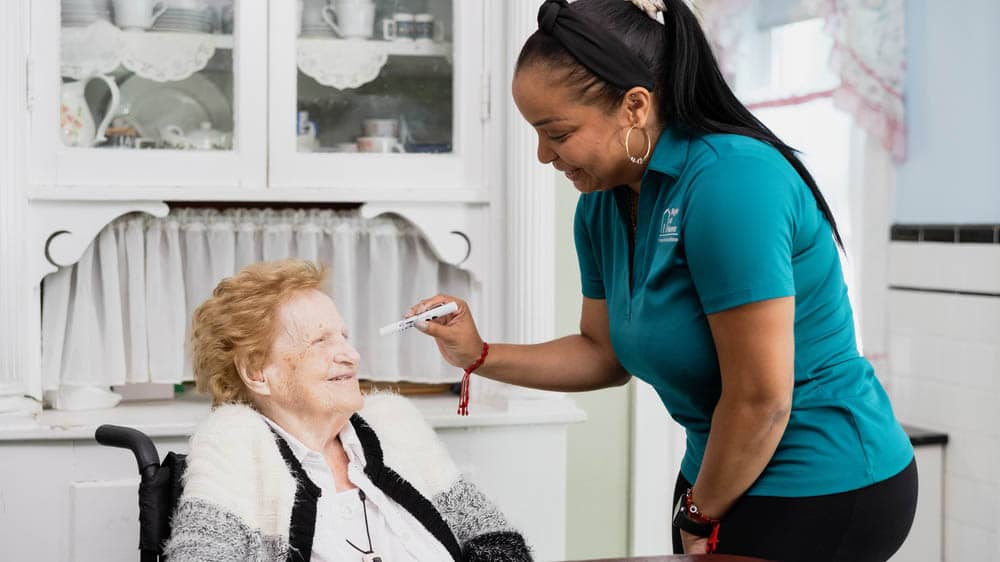

If You’re Diabetic, We Have Our Eyes on You
The American Diabetes Association (ADA) notes that more than 29% of Americans age 65 and older, or 16 million seniors, have diabetes. The statistic includes diagnosed and undiagnosed cases. Diabetes is chronic and occurs when blood sugar is too high. If left untreated over time, diabetes can damage the eyes and cause vision loss. The disease can also damage the heart, blood vessels, kidneys and nerves.
Focusing on Chronic Diabetic Eye Conditions
Eye problems due to diabetes include cataracts, glaucoma, diabetic retinopathy, and macular edema.
Cataracts: Cataracts are a common issue among the elderly. A cataract is a cloudy area over the lens of the eye and is a major cause of visual problems in diabetic individuals. The National Eye Institute notes that people who have diabetes are two to five times more likely to develop a cataract. Cataracts are treated by surgically removing the cloudy lens and replacing it with a synthetic lens.
Glaucoma: Glaucoma is a group of eye diseases that can damage the optic nerve that connects the eye to the brain. The National Institutes of Health states that diabetes doubles the chances of having glaucoma, which can lead to vision loss and blindness if not treated early. Treatments for glaucoma include eye drops, laser treatment, and surgery.
Diabetic Retinopathy: People who have Type 1 and Type 2 diabetes risk developing diabetic retinopathy. It occurs when high blood sugar damages the blood vessels in the retina. The Centers for Disease Control and Prevention (CDC) identifies two stages of diabetic retinopathy:
- Early stage – In early-stage retinopathy, blood vessels in the walls of the retina weaken and bulge, forming tiny pouches that can leak blood and other fluid, which can cause a part of the retina called the macula to swell, resulting in macular edema. Macular edema is the most common cause of blindness in people with diabetic retinopathy. An estimated half of those with diabetic retinopathy will develop macular edema. In early-stage diabetic retinopathy, symptoms might not be noticeable, making it even more important to get a dilated eye exam once a year so any problems can be identified early when treatment is most effective.
The ADA notes that a diabetic individual can have 20/20 vision and still have diabetic retinopathy. Some of the early signs include:
- Cloudy vision
- Trouble seeing at night
- Seeing double
- Blurry vision in only one eye
- Redness or pain in the eye
- Spots or dark shapes in the vision (floaters)
- Loss of peripheral vision
- Advanced stage – In the advanced stage of retinopathy, the retina begins to grow blood vessels, which are fragile. Because the vessels are fragile, they often bleed into the clear gel (vitreous) between the lens and retina. With minor bleeding, individuals may see dark spots that float in their vision. Vision may be blocked entirely if there is a lot of bleeding.
Symptoms in the advanced stage can include:
- Spots or dark shapes in the vision (floaters)
- Blurry vision
- Trouble seeing colors
- Dark or empty areas in the vision
- Vision loss
According to the CDC, treating diabetic retinopathy can repair damage to the eye and even prevent blindness in most people. Treatment can start before sight is affected, which helps prevent vision loss. Options include:
- Laser therapy, which creates a barrier of scar tissue that slows the growth of new blood vessels.
- Medicines called VEGF inhibitors, which block the growth of abnormal blood vessels. This can slow down or reverse diabetic retinopathy.
- Removing all or part of the vitreous, the gel-like fluid that fills the eye.
- Reattachment of the retina.
- Injection of medicines called corticosteroids.
Helpful Resources for Those With Diabetic Eye Conditions
To find in-depth information about diabetic eye conditions, check out the following websites:
- Centers for Disease Control and Prevention
- The National Eye Institute
- The American Diabetes Association
- AARP
- The National Institutes of Health
How Right at Home Can Help
A cohesive team of family members, friends and professional caregivers can help an older adult with vision challenges maintain their condition as best as possible. One of the most essential supports is making sure the loved one keeps up with regular, comprehensive eye exams and treatment. Right at Home’s professionally trained in-home caregivers provide many services for clients with diabetes, including:
- Education about diabetes management and assistance with handling health appointments and activities.
- Nutritional support, including meal planning and preparation and grocery shopping.
- Supervision and encouragement as the client follows the doctor’s exercise “prescription.”
- Companionship to lift the client’s spirits and ward off depression, which is common among seniors with diabetes.
- Respite care and an extra pair of hands to lower caregiver stress.
- Transportation to medical appointments, exercise classes—wherever the client needs and wants to go.
- Housekeeping and personal care to keep the client safe and comfortable at home.
To learn more about how Right at Home can help, find a local Right at Home office and download the free Adult Caregiving Guide.
To find a support group, visit:







